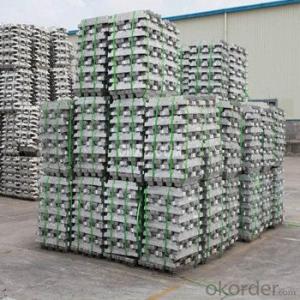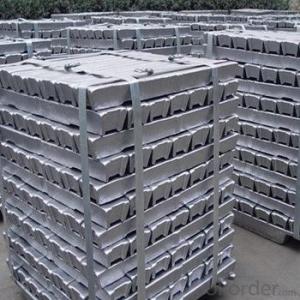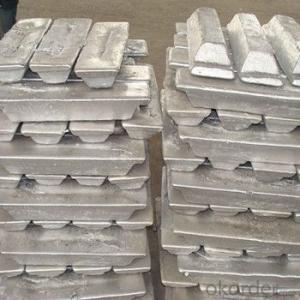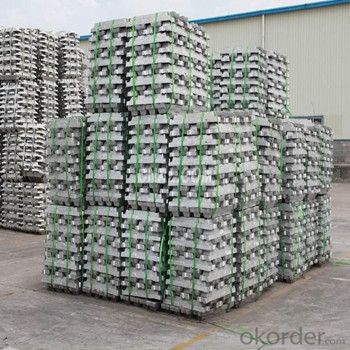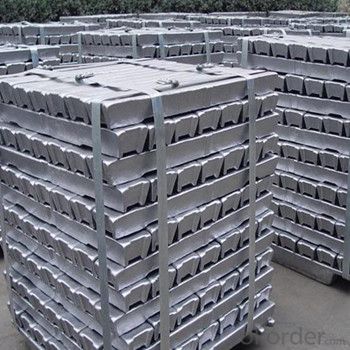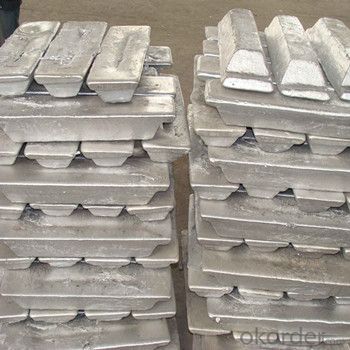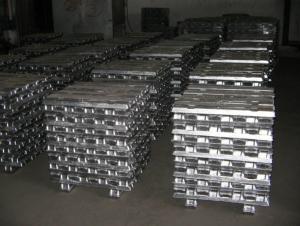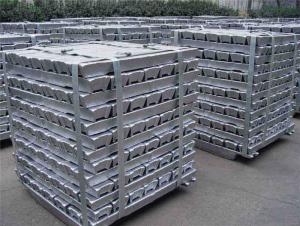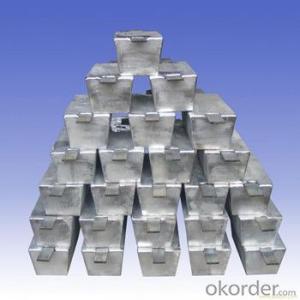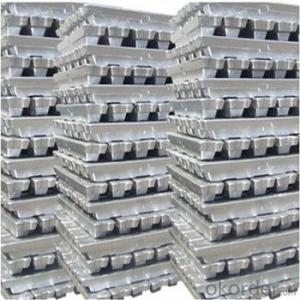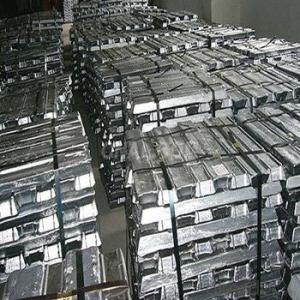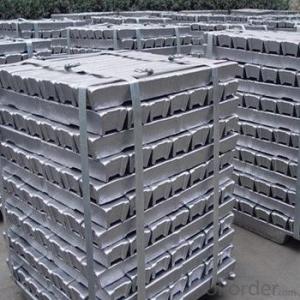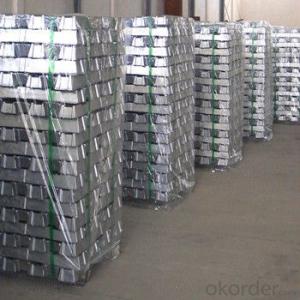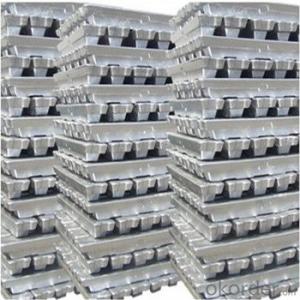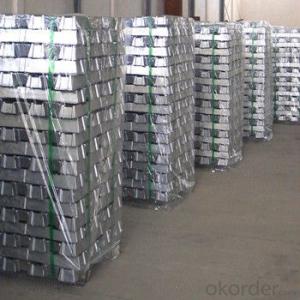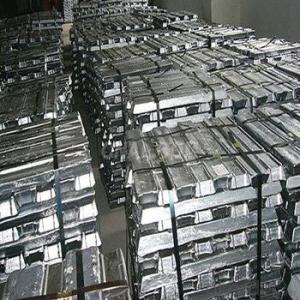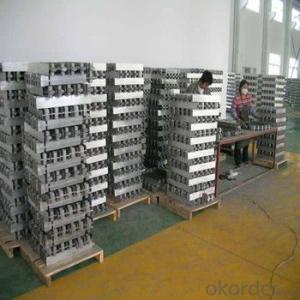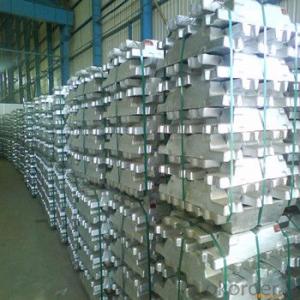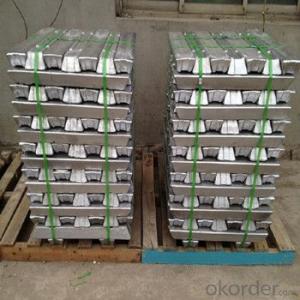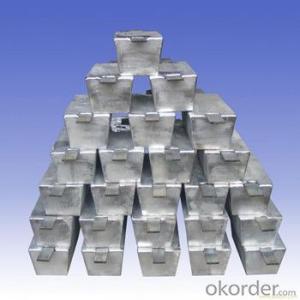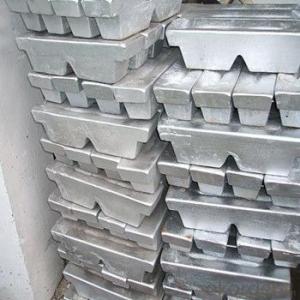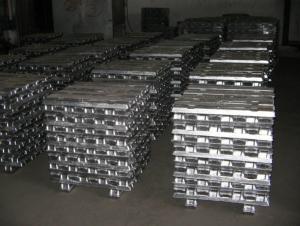Aluminum Pig/Ingot 2015 Hot Sale Products
- Loading Port:
- China main port
- Payment Terms:
- TT OR LC
- Min Order Qty:
- 1 m.t.
- Supply Capability:
- 100000 m.t./month
OKorder Service Pledge
OKorder Financial Service
You Might Also Like
Pure Aluminum Pig/Ingot Used for Industry
1.Structure of Aluminum Pig/Ingot
A material that has been cast into a shape in order to be transported and processed easier than in an unprocessed form. An ingot is typically rectangular in shape, which allows it to be stacked. Ingots are most commonly associated with metals, with ingots of gold held in the vaults of banks and brokerages being popular images.
Aluminum Ingot is with the AL as the main chemical composition.Aluminum Ingot is used for industry,such as automobile,pinning and weaving,electron broadly and so on. Aluminum Ingot has the following advantages: easy control and operation, fast melting.
2.Main Features of the Aluminum Pig/Ingot
•High Purity
•Easy control and operation
•High strength
•Fast melting
•Competitive price
•Best Service
3.Aluminum Pig/Ingot Images
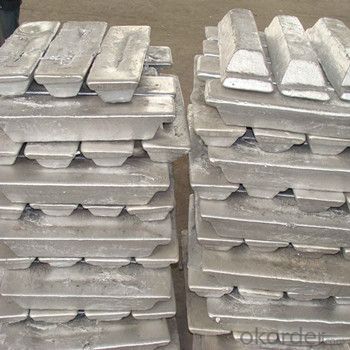
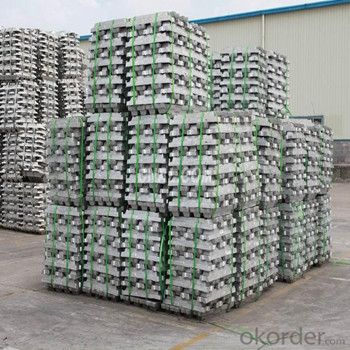
4.Aluminum Pig/Ingot Specification
Grade | Chemical Composition % | |||||||||
Al≥ | impurities ≤ | |||||||||
Si | Fe | Cu | Ga | Mg | Zn | Mn | others | Sum | ||
Al99.9 | 99.90 | 0.50 | 0.07 | 0.005 | 0.02 | 0.01 | 0.025 | - | 0.010 | 0.10 |
Al99.85 | 99.85 | 0.80 | 0.12 | 0.005 | 0.03 | 0.02 | 0.030 | - | 0.015 | 0.15 |
Al99.7 | 99.70 | 0.10 | 0.20 | 0.010 | 0.03 | 0.02 | 0.030 | - | 0.030 | 0.30 |
Al99.6 | 99.60 | 0.16 | 0.25 | 0.010 | 0.03 | 0.03 | 0.030 | - | 0.030 | 0.40 |
Al99.5 | 99.50 | 0.22 | 0.30 | 0.020 | 0.03 | 0.05 | 0.050 | - | 0.030 | 0.50 |
Al99.00 | 99.00 | 0.42 | 0.50 | 0.020 | 0.03 | 0.05 | 0.050 | - | 0.050 | 1.00 |
5.FAQ of Aluminum Pig/Ingot
We have organized several common questions for our clients,may help you sincerely:
①How about your company?
A big and famous and professional manufacturer & supplier of Aluminum Pig/Ingot, is one of the one of the large-scale professional investment Aluminum Pig/Ingot production bases in China.It have focuses on producing the Aluminum Pig/Ingot production for many years and gotten rich experience.Annually lagrge amount of Aluminum Pig/Ingot production are exported to markets in Europe,America and Japan. The quality and service have also gotten OEM service is available according to customer’s requirements.
②How to guarantee the quality of the products?
We have established the international advanced quality management system,every link from raw material to final product we have strict quality test;We resolutely put an end to unqualified products flowing into the market. At the same time, we will provide necessary follow-up service assurance.
③How long can we receive the product after purchase?
In the purchase of product within three wo We have organized several common questions for our clients,may help you sincerely:
①How about your company?
A big and famous and professional manufacturer & supplier of Aluminum Pig/Ingot, is one of the one of the large-scale professional investment Aluminum Pig/Ingot production bases in China.It have focuses on producing the Aluminum Pig/Ingot production for many years and gotten rich experience.Annually lagrge amount of Aluminum Pig/Ingot production are exported to markets in Europe,America and Japan. The quality and service have also gotten OEM service is available according to customer’s requirements.
②How to guarantee the quality of the products?
We have established the international advanced quality management system,every link from raw material to final product we have strict quality test;We resolutely put an end to unqualified products flowing into the market. At the same time, we will provide necessary follow-up service assurance.
③How long can we receive the prod rking days, We will arrange the factory delivery as soon as possible. The pecific time of receiving is related to the state and position of customers.Commonly 7 to 10 working days can be served.
- Q: How much capital do I need to invest in the recycled aluminium ingot?
- This mainly depends on how much money you scale, there are local to not to do this, I am here in Foshan now, we're not here to make this move to distant places to engage in equipment, don't need how much, I have many friends in this, but now we're not here to do
- Q: Why milling through milling machine before rolling aluminium ingot?
- I say the oxide film refers to the aluminum ingot when hot rolling or heating should not form excessive oxide film, otherwise it must be added after the hot rolling milling process;
- Q: What are the advantages of using aluminum ingots in the production of electrical transmission lines?
- Using aluminum ingots in the production of electrical transmission lines offers several benefits. Firstly, aluminum, being a lightweight metal, is easier to transport and install compared to materials like copper, reducing overall costs and effort involved in construction and maintenance. Secondly, aluminum possesses excellent conductivity properties, enabling efficient transmission of electricity. This results in less energy loss during transmission, increasing efficiency and minimizing power wastage. Furthermore, aluminum exhibits high resistance to corrosion, making it ideal for outdoor applications. It can withstand harsh weather conditions and environmental factors, ensuring the longevity and reliability of transmission lines. Additionally, aluminum is a cost-effective option due to its abundance and relatively low extraction cost. This affordability makes it a suitable choice for large-scale transmission line projects. Moreover, aluminum is highly recyclable, making it environmentally friendly. The recycling process requires significantly less energy compared to the production of virgin aluminum, reducing carbon emissions and energy consumption. Lastly, aluminum ingots can be easily shaped into various forms, allowing for flexibility in transmission line design and construction. This adaptability ensures optimal functionality in different terrains and installation requirements. In conclusion, the advantages of using aluminum ingots in electrical transmission line production include lightweight construction, high conductivity, corrosion resistance, cost-effectiveness, recyclability, and design flexibility. These benefits make aluminum a preferred choice for efficient and sustainable electricity transmission.
- Q: How is aluminum ingot different from aluminum billet?
- Aluminum ingot and aluminum billet are both forms of aluminum metal, but they differ in terms of their shape, size, and manufacturing process. Aluminum ingot is typically produced through a primary aluminum production process called smelting. It is a large rectangular block or slab of solid aluminum with a standardized shape and size. The ingot is usually obtained by casting molten aluminum into a mold and allowing it to cool and solidify. Aluminum ingots are commonly used as raw materials for further processing, such as rolling, extrusion, or forging, to produce various aluminum products. On the other hand, aluminum billet is a semi-finished product that is often derived from aluminum ingots. Billets are usually obtained by heating and continuously casting molten aluminum into a cylindrical shape and then allowing it to cool and solidify. Unlike ingots, billets have a smaller cross-sectional area and a longer length. They are commonly used as starting material for extrusion processes, where they are heated and forced through a die to produce complex shapes like rods, bars, profiles, or tubes. In summary, while both aluminum ingots and aluminum billets are made of the same material, their differences lie in their shape, size, and purpose. Ingots are large rectangular blocks used as raw materials for further processing, while billets are smaller cylindrical shapes used as starting material for extrusion processes.
- Q: What are the different alloying elements used in aluminum ingots?
- There are several different alloying elements that can be used in aluminum ingots to enhance various properties and characteristics of the metal. Some of the commonly used alloying elements include: 1. Copper (Cu): Copper is often added to aluminum ingots to increase the strength and hardness of the alloy. Copper-aluminum alloys, also known as aluminum bronzes, have excellent corrosion resistance and are widely used in marine applications. 2. Zinc (Zn): Zinc is commonly used as an alloying element in aluminum ingots to improve the castability of the metal. Aluminum-zinc alloys, such as the 7000 series, have high strength, good corrosion resistance, and are often used in aerospace and automotive applications. 3. Magnesium (Mg): Magnesium is a widely used alloying element in aluminum ingots, especially in the 5000 series alloys. It improves the strength and machinability of the aluminum and provides good corrosion resistance. Aluminum-magnesium alloys are commonly used in structural applications. 4. Silicon (Si): Silicon is added to aluminum ingots to improve their casting characteristics and reduce shrinkage during solidification. Aluminum-silicon alloys, such as the 4000 series, have good fluidity and are often used in automotive and electronic components. 5. Manganese (Mn): Manganese is used as an alloying element in aluminum ingots to increase strength and improve corrosion resistance. Aluminum-manganese alloys, such as the 3000 series, have good formability and are commonly used in construction and packaging industries. 6. Chromium (Cr): Chromium is added to aluminum ingots to improve their heat resistance and enhance their mechanical properties. Aluminum-chromium alloys, such as the 2000 series, are often used in aerospace and high-temperature applications. 7. Lithium (Li): Lithium is a lightweight and highly reactive element that is used in small amounts to create high-strength, low-density aluminum-lithium alloys. These alloys are primarily used in aerospace applications where weight reduction is critical. These are just some of the alloying elements used in aluminum ingots. The choice of alloying elements depends on the desired properties of the final product and the intended application.
- Q: What is aluminium ingot? Is it different from other series of aluminum?
- The problem lies in the production process, the mold work with a problem, to the mold work belt repair, this you have to let manufacturers solve.
- Q: What quality aluminium ingots can be made out of pop cans?
- In fact, the recycled aluminum slag can also be used for smelting aluminum ingots. But it doesn't work well. It needs stirring and a lot of slag. There is also a saying that the only way aluminum slag smelting aluminum ingot is electrolysis, the use of reduction method is too expensive
- Q: Can aluminum ingots corrode?
- Yes, aluminum ingots can corrode. Although aluminum is known for its corrosion resistance, it is not completely immune to corrosion. When exposed to certain environments, such as salty or acidic conditions, aluminum can undergo a process called oxidation, which results in the formation of a thin layer of aluminum oxide on its surface. This layer acts as a protective barrier, preventing further corrosion. However, if this layer is damaged or compromised, the underlying aluminum can be exposed to corrosive elements, leading to corrosion. Therefore, while aluminum ingots are generally resistant to corrosion, proper care must be taken to protect them in corrosive environments.
- Q: What are the health risks associated with working with aluminum ingots?
- Certain health risks can be associated with working with aluminum ingots due to the potential exposure to various hazards. The following are some health risks that are commonly associated with working with aluminum ingots: 1. Inhaling aluminum particles: There is a risk of inhaling fine aluminum particles during the handling and processing of aluminum ingots. Prolonged exposure to aluminum dust or fumes can lead to respiratory problems such as bronchitis, pulmonary fibrosis, or even lung cancer. 2. Irritation of the skin and eyes: Direct contact with aluminum ingots or its dust can cause skin irritation, redness, and rashes. It may also cause eye irritation, resulting in redness, itching, or a burning sensation. 3. Potential neurological effects: Chronic exposure to aluminum, especially through inhalation or ingestion, has been linked to possible neurological effects. Although the exact mechanisms are not fully understood, there is some evidence suggesting a connection between aluminum exposure and the development or progression of neurodegenerative diseases, such as Alzheimer's disease. 4. Occupational asthma: Exposure to aluminum dust or fumes can trigger or worsen asthma symptoms in individuals who are already prone to respiratory conditions. This can lead to difficulties in breathing, wheezing, coughing, and chest tightness. 5. Heavy metal toxicity: Aluminum is classified as a heavy metal, and excessive exposure can result in heavy metal toxicity. Symptoms of aluminum toxicity may include gastrointestinal issues, bone pain, muscle weakness, and potential damage to the nervous system. To minimize these health risks, it is crucial to implement appropriate safety measures and adhere to proper protocols when working with aluminum ingots. This includes wearing personal protective equipment (PPE) such as gloves, goggles, and respiratory masks, ensuring adequate ventilation in the workplace, and regularly cleaning to reduce the accumulation of aluminum dust. Additionally, individuals working with aluminum ingots are advised to undergo regular medical check-ups and monitoring to detect any potential health issues at an early stage.
- Q: How are aluminum ingots used in the production of railway components?
- Aluminum ingots are used in the production of railway components as they serve as the raw material for casting or forging various parts such as frames, body panels, doors, windows, and even wheels. These ingots are melted down and then shaped into the desired components through processes like extrusion or machining. The use of aluminum in railway components offers advantages like lightweight construction, corrosion resistance, and improved energy efficiency.
Send your message to us
Aluminum Pig/Ingot 2015 Hot Sale Products
- Loading Port:
- China main port
- Payment Terms:
- TT OR LC
- Min Order Qty:
- 1 m.t.
- Supply Capability:
- 100000 m.t./month
OKorder Service Pledge
OKorder Financial Service
Similar products
Hot products
Hot Searches
Related keywords
